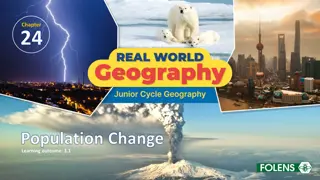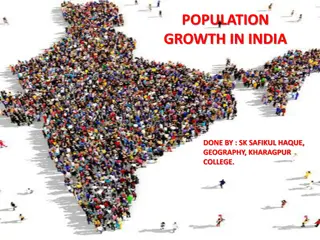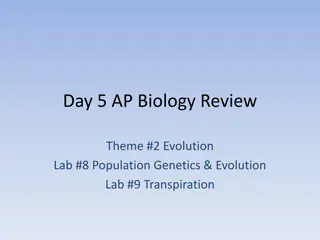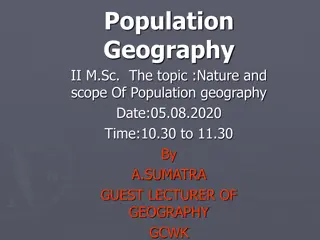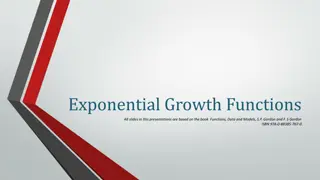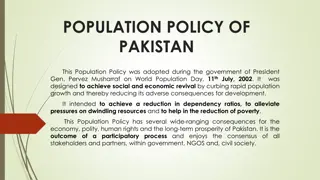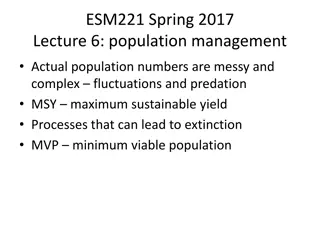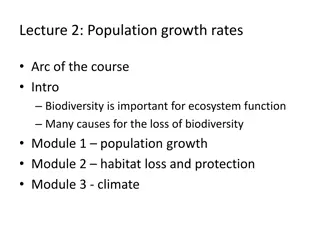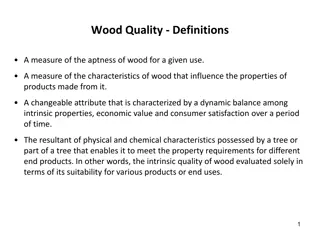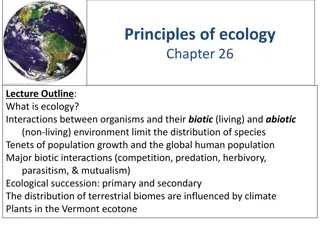Understanding Population Growth: Characteristics and Factors
Explore how populations grow through geographic distribution, density, and growth rate. Discover examples of different population distributions and learn about the factors affecting population size, including birthrate and death rate.
Download Presentation

Please find below an Image/Link to download the presentation.
The content on the website is provided AS IS for your information and personal use only. It may not be sold, licensed, or shared on other websites without obtaining consent from the author. Download presentation by click this link. If you encounter any issues during the download, it is possible that the publisher has removed the file from their server.
E N D
Presentation Transcript
Chapter 5 Populations 5-1 How Populations Grow
How Populations Grow Characteristics of Populations Three important characteristics of a population 1. Geographic distribution 2. Density 3. Growth rate
Geographic Distribution A population s range can vary enormously in size, depending on the species. Bacteria in pumpkin vs cod swimming from Greenland- North Carolina
2- Population Density Population density is the number of individuals per unit area. The population of ducks in a pond may have a low density, while fish in the same pond have a higher density
Density and Distribution An example of a population that shows random distribution is the purple lupine. http://cdn.c.photoshelter.com/img-get/I0000ZwlJW3Rm59E/s/900/900/California-Wildflowers-Spring-01.jpg
Density and Distribution An example of a population that shows uniform distribution is the king penguin. http://pdsblogs.org/2011pdsapes8/files/2010/11/uniform-penguins.jpg
Density and Distribution An example of a population that shows clumped distribution is bacteria. http://water.me.vccs.edu/courses/env108/clipart/results2.jpg
Populations Growth Three factors can affect population size: number of births the number of deaths the number of individuals that enter or leave the population. * Simply put, a population will increase or decrease in size depending on how many individuals are added to it or removed from it
Birthrate and Death Rate A population can grow when its birthrate is higher than its death rate. If the birthrate equals the death rate, the population may stay the same size. If the death rate is greater than the birthrate, the population is likely to shrink.
Immigration & Emmigration Immigration the movement of individuals into an area, is another factor that can cause a population to grow. Emigration the movement of individuals out of an area, can cause a population to decrease in size.
Exponetial Growth Exponential Growth If a population has abundant space and food, and is protected from predators and disease, then organisms in that population will multiply and the population size will increase.
Checkpoint Which of the following is NOT a condition for a population to reach exponential growth? A.) presence of unlimited resources B.) Absence of predation and disease C.) movement of individuals out of the population
Logistic Growth Logistic growth occurs when a population's growth slows or stops following a period of exponential growth. As resources become less available, the growth of a population slows or stops. The general, S-shaped curve of this growth pattern, called logistic growth
Carrying Capacity The number or the largest number of individuals that a given environment can support.
Phase 1: Exponential Growth
Phase 2: Growth Slows Down.



